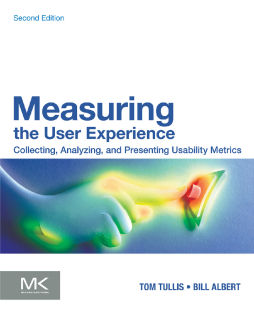
Additional Information
Book Details
Abstract
Measuring the User Experience was the first book that focused on how to quantify the user experience. Now in the second edition, the authors include new material on how recent technologies have made it easier and more effective to collect a broader range of data about the user experience.
As more UX and web professionals need to justify their design decisions with solid, reliable data, Measuring the User Experience provides the quantitative analysis training that these professionals need. The second edition presents new metrics such as emotional engagement, personas, keystroke analysis, and net promoter score. It also examines how new technologies coming from neuro-marketing and online market research can refine user experience measurement, helping usability and user experience practitioners make business cases to stakeholders. The book also contains new research and updated examples, including tips on writing online survey questions, six new case studies, and examples using the most recent version of Excel.
- Learn which metrics to select for every case, including behavioral, physiological, emotional, aesthetic, gestural, verbal, and physical, as well as more specialized metrics such as eye-tracking and clickstream data
- Find a vendor-neutral examination of how to measure the user experience with web sites, digital products, and virtually any other type of product or system
- Discover in-depth global case studies showing how organizations have successfully used metrics and the information they revealed
- Companion site, www.measuringux.com, includes articles, tools, spreadsheets, presentations, and other resources to help you effectively measure the user experience
"If Tom and Bill could convince me, perhaps the world’s biggest fan of qualitative testing, that usability metrics are really valuable—which they have, in this wonderful book—then there’s no doubt they’ll convince you. I loved reading this book, because it was exactly like having a fascinating conversation with a very smart, very seasoned, and very articulate practitioner. They tell you everything you need to know (and no more) about all the most useful usability metrics, explain the pros and cons of each one (with remarkable clarity and economy), and then reveal exactly how they actually use them after years and years of real world experience. Invaluable!" Steve Krug, author of Don’t Make Me Think: A Common Sense Approach to Web Usability "This book is a great resource about the many ways you can gather usability metrics without busting your budget. If you’re ready to take your user experience career to the next level of professionalism, Tullis and Albert are here for you and share generously of their vast experience. Highly recommended." Jakob Nielsen, Principal, Nielsen Norman Group, author of Usability Engineering and Eyetracking Web Usability "If you do any type of usability testing, you need this book. Tullis and Albert have written a clear and comprehensive guide with a common-sense approach to usability metrics." Ginny Redish, President of Redish and Associates, Inc., author of Letting Go of the Words
"The book is well-structured for the practitioner…. It is a real pleasure to encounter a book that not only takes the reader on a journey through the rich possibilities of technique, but does so in a a manner that is clear, readable, and accessible. I was particularly pleased with the simple explanations of statistical techniques, which are so often presented as incomprehensible…. Whether you’ve conducted remote studies in the past and want to extend your capability and knowledge, or if you are a complete newcomer, this excellent book is a necessary companion on your journey from the lab into the outside world. You will refer to it often, and it will alert you to opportunities and dangers. What more could you ask of a book?" Gerry Gaffney, User Experience, Vol 10, Issue 2, 2nd Quarter, 2011
